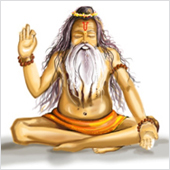Tree in Water Colour:
1. Introduction:
This section introduces tools, basic painting techniques and procedure used in water colour painting. The coming subsections carefully explain painting illustration of a tree with water colour. The painting is also demonstrated through a video, where the whole illustration is recorded. At the end of this module the targeted viewer will be introduced to various aspects in water colour painting with its tools and techniques.
2. Tools:
No. 11 and No. 3 round brushes are used to illustrate the tree. No. 11 brush is used to paint the colours on the surface of the tree and No. 3 brush is used for detail works, like drawing leaves, branches, creating texture etc. The water colours used in the illustration are Lemon yellow, Ochre yellow, Sap green, Viridian hue, Persian blue. The colours are sometimes mixed together to produce relatively different colour tones which is shown in an example below.
Colour Chart

Procedure:
• Contour Drawing:
A light contour of the tree is outlined on the paper that helps to guide the painter to move his brushes accordingly. Contour drawing is very useful for the painter, it gives an idea whether the different elements in the object are proportioned and at the same time helps to visualise the object before starting to paint.
• Colours:
Light to dark colour shades are created to understand tonal variations. These tonal variations are used while painting the tree. Top to bottom tonal variations used in the example are used for painting the tree in the illustration (figure right).
Similarly, different colours along with their shades can be used to paint a tree. The colours selected will depend on the type of the tree that is drawn and the source of light. In the illustration lemon yellow is used to highlight the sunlight and the tree illustrated here is assumed dense leaves with branches and a strong and thick stem.

• Four basic types of brushes:
The brushes that are basically used in water colour painting are as follows:
i. Round Brushes:
The beginners are usually advised to use these types of brushes initially.
It helps them in perfecting brush control. These brushes are mostly used for water colour and stroke works. These brushes come in different numbers and types.

Flat brushes are most commonly used in painting. These brushes can be used for base coating, stroke work, floating, blending, washes and varnishing. They come in different numbers and types.

iii. Flat Oval Brushes:
It is basically a flat brush but with a rounded edge. These brushes can be used for creating shades and highlights.
It is also used for blending since it is thicker and can hold good amount of water and can be used for applying washes of colour. Because of its shape it can be used for creating leaves, flower petals etc.
These brushes come in different numbers and types.

iv. Liner Brushes:
These brushes are generally used to create fine lines like eyelashes, calligraphy etc. These brushes come in different lengths, thickness and numbers and types.

• Painting:
Step 1:
Initially the painting is started from the top portion, in the illustration assuming that the sunlight is falling from top; the top portion of the tree receives direct sunlight. These highlighted areas are painted with light colours. Generally no. 11 brush is used to paint these highlighted areas with lemon yellow which is the lightest colour tone among the colours that have been chosen in the illustration.
Step 2:
Gradually we move downwards to paint the leaves of the tree with the lighter tone of the green colour and while we move further downwards we use darker tone of the same colour for the leaves. This tonal variation is adapted since the light diminishes in the downward direction on the surface of an object if the source of the light falling on the object is from the top. Therefore, a colour used in the upward portion of the tree gradually becomes darker as it moves downwards considering the source of light.
Step 3:
While painting the tree from light to dark colours, stokes of leaves and branches are also created simultaneously. These strokes are created with no. 3 brush which gives a fine touch while detailing.
Step 4:
Eventually darker colour tones are used to highlight the depth areas. The darkest tone is used to highlight the shadow of the tree that is cast in the opposite direction of the light source. The grass is created with brush strokes and the ground painted with the respective colours keeping in mind the direction and the source of the light.
In the example the illustrator has used these colours but various other colours can be used to illustrate different trees, depending on its light source and other elements such as density of the leaves, branches, structure and texture of the stem.
• Furnishing Details:
In the final step, brush no.3 is used for detail painting. These processes make the painting visually attractive and look more realistic. During this process the tree is gradually transformed into more three dimensional and realistic figures through the effect of the colours and their various tones. Note that the quality of tones should also reflect the quality of the material – for example the hair, the beads, the cloth, the skin – all have different textural qualities different from one another. A keen sense of observation will help you to note the subtle differences in the treatment of light and dark colours to achieve the right texture.
Detailed leafs and small branches are also drawn. Darker colour shades are used to colour the shadow portion of the tree trunk and lighter colour is used to colour the highlighted portions. The ground is painted and grass drawn with brush strokes.
Check the Video for details of the step by step process of illustration.

